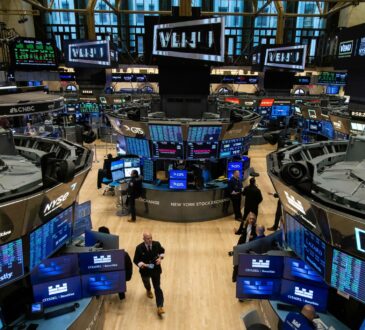
We recently looked at Goldman Sachs’ Stocks With Highest Consensus Returns: 42 Stocks With The Highest Consensus ROE. In this piece, we will look at where CarMax, Inc. (NYSE:KMX) ranks in the list.
As the fourth quarter of 2024 settles in, the narrative surrounding stocks on Wall Street is starting to shift. This is unsurprising since the beginning of the Federal Reserve’s interest rate cycles stands to change economic conditions in America. These will naturally affect businesses, and cyclical stocks along with financials should see an improved outlook.
For instance, consider two reports by investment bank Morgan Stanley. One of these was released before the interest rate cut, and it covered the bank’s thoughts about the stock market and the US economy for September. The other came in October, after the rate cut. In its September report, MS laid out three scenarios for the flagship S&P index’s performance for the rest of this year. The best case scenario posits that the index would close at 5,650 points in the near term, while the “attractive” and “fair” scenarios predict a closing of 5,200 and 5,350 points, respectively. Yet, the market has outperformed even the best scenario, as its recent reading is 5,764.
The bank also shares that inflation is finally dropping in America. This fact is explained through the S&P’s second quarter earnings performance. In fact, the shifting inflationary trends have set new highs for a decade when we consider sales and earnings surprises for the index according to MS. Its data shows that when inflation was soaring in Q4 2022, the net of positive and negative EPS surprises stood in lowest quintile since businesses struggled with costs. This was despite the fact that during the same time period the net of positive and negative revenue surprises was in the 70% percentile. However, now that inflation has dropped, data for the second quarter earnings season shows that the EPS surprise was in the uppermost quintile (above 80%) while the revenue surprise had dropped to roughly 35%. This data covers the past ten years, and as a result, it illustrates the momentous shifts that the market is undergoing right now.
Since interest rates are the hottest topic on Wall Street, MS also commented on its expectations for them. At the September start, the bank posited that markets were expecting 100 basis points of cuts by 2024 end. The bank shared that it thought “this looks aggressive unless the U.S. economy has a hard landing, but this is not our base case.” With September’s 50 basis points cut out of the way, these expectations have remained unchanged as the CME Fed Watch Tool shows that for the Fed’s November and December meetings, the market has set the probabilities for a 25 basis point cut in each at 85.5% and 82.1%, respectively. These cuts are important for determining the market’s direction, as MS’ data shows that when economic activity as measured by the ISM Manufacturing Index sat at ~67 in 2010, the S&P’s 12 month total return was 30%.
Shifting gears to the October report, MS cautions that while historically equities have outperformed following the first Fed rate cut, elevated valuations, and “consensus forecasting of EPS acceleration rather than decline, equities upside after the first cut may prove more limited this cycle.” The bank’s key stock market insight from its October report comes through its comments about cyclical stocks, though. MS shares that as upward economic growth surprises softened from April through August, “sector and factor trends skewed defensive, consistent with softer economic growth.” However, this might not be the case moving forward, as shown by the Citi Global Economic Surprise Index. MS outlines that this index had bottomed out in August with a ~-25 reading, which had jumped to roughly -12 in September. This trend was mirrored in the difference between global cyclical and defensive sectors, with the reading also moving upward as the economic surprises jumped.
These factors are key when we analyze Goldman Sachs’ list of stocks with the highest expected ROE since the bank believes that stock quality will be determined by economic growth and economic rates. The bank also recently upped its 2024 closing target for the S&P to 6,000 points. This was the fourth revision of its target and a sizeable increase from the previous estimate of 5,600 points. This increase was also accompanied by optimism for the index’s earnings. GS now believes that S&P’s 2025 earnings will sit at $268, for a 4.7% revision from the previous estimate of $256. Its 2024 estimate is unchanged, though, and its value of $241 implies that earnings next year will grow by 11.2%.
As for the next 12 months, GS believes that the S&P will sit at 6,300 points, for an 8.9% growth over its recent value of 5,779. As MS’ data pointed out that EPS surprises are growing as inflation tames, Goldman is also of a similar view. This is because the bank’s chief US equity strategist David Kostin shares that the upward EPS revision is reflective of the fact that the “macro backdrop remains conducive to modest margin expansion, with prices charged outpacing input cost growth.” In a later note, the analyst outlined that “Over the past year, performance of several quality factors has tracked the broad trajectory of market views on growth and monetary policy.” Kostin added that “A positive jobs print could prompt some investors to rotate out of expensive ‘quality’ stocks into less-loved lower quality firms as the market would likely price lower odds of substantial labor market weakening.”
Our Methodology
To make our list of Goldman Sachs’ stocks with the highest consensus ROE, we used the bank’s latest list of 50 such stocks and chose those with a 5% or higher consensus ROE.
For these stocks, we also mentioned the number of hedge fund investors. Why are we interested in the stocks that hedge funds pile into? The reason is simple: our research has shown that we can outperform the market by imitating the top stock picks of the best hedge funds. Our quarterly newsletter’s strategy selects 14 small-cap and large-cap stocks every quarter and has returned 275% since May 2014, beating its benchmark by 150 percentage points. (see more details here).


A senior manager studying a market index alongside a team of young stock market analysts.
CarMax, Inc. (NYSE:KMX)
Consensus ROE: 5%
Number of Hedge Fund Investors in Q2 2024: 35
CarMax, Inc. (NYSE:KMX) is an American used car retailer. The firm provides used cars and financing for the vehicles. Its stock is up by a modest 1.6% over the past twelve months and is down 6.6% year to date. This is unsurprising given the glut that the US auto industry has suffered from due to high rates and high inflation. As the number of new unsold cars on lots grows, their prices drop which also affects the market for CarMax, Inc. (NYSE:KMX)’s vehicles. Additionally, its presence in the auto financing market has meant that the firm has had to struggle with non performing loans because of high interest rates. However, over the long term, CarMax, Inc. (NYSE:KMX)’s market presence as indicated by $25.9 billion in trailing twelve month revenue means that the firm has adequate resources to benefit from a recovery. It also enables the company to target the growing trend of online used car retailing as smaller firms that are the majority in the US used car market often lack the resources to develop an omnichannel strategy.
Alphyn Capital mentioned CarMax, Inc. (NYSE:KMX) in its Q2 2024 investor letter. Here is what the fund said:
“CarMax, previously a winning investment for us, has disappointed us recently. As per the discussion at the start of this letter, I am re-underwriting my thesis carefully. Two key factors impacted CarMax: the rise of online competitors like Carvana and franchised dealerships entering the used car market and a post-pandemic environment with higher financing costs and less affordable cars. Their traditional brick-and-mortar, no-haggle model, while successful historically, faced challenges. In response, CarMax invested significantly in omnichannel offerings and technology to enable efficient car sourcing from consumers and dealers in a supply-constrained market. While this strengthens their long-term position, it has put temporary pressure on profits. Moreover, CarMax prioritizes consistent margins per car (~$2,500), which has impacted sales volume in recent quarters compared to competitors focused primarily on sales growth.
The used car market will eventually normalize, which should lead to positive operational leverage in CarMax from its recent investments. The company benefits from long-tenured management that has successfully navigated difficult macro conditions before. Management has shown adaptability with the omnichannel rollout and willingness to experiment with auto financing for lower-credit customers. I am carefully assessing the risk-reward against cash and other opportunities that I am looking into.”
Overall KMX ranks 42nd on our list of stocks with the highest consensus ROE according to Goldman Sachs. While we acknowledge the potential of KMX as an investment, our conviction lies in the belief that some AI stocks hold greater promise for delivering higher returns and doing so within a shorter timeframe. If you are looking for an AI stock that is more promising than KMX but that trades at less than 5 times its earnings, check out our report about the cheapest AI stock.
READ NEXT: $30 Trillion Opportunity: 15 Best Humanoid Robot Stocks to Buy According to Morgan Stanley and Jim Cramer Says NVIDIA ‘Has Become A Wasteland’.
Disclosure: None. This article was originally published on Insider Monkey.


